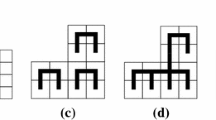Abstract
The algorithmic self-assembly of shapes has been considered in several models of self-assembly. For the problem of shape construction, we consider an extended version of the two-handed tile assembly model, which contains positive (attractive) and negative (repulsive) interactions. As a result, portions of an assembly can become unstable and detach. In this model, we utilize fuel-efficient computation to perform Turing machine simulations for the construction of the shape. In this paper, we show how an arbitrary shape can be constructed using an asymptotically optimal number of distinct tile types (based on the shape’s Kolmogorov complexity). We achieve this at O(1) scale factor in this straightforward model, whereas all previous results with sublinear scale factors utilize powerful self-assembly models containing features such as staging, tile deletion, chemical reaction networks, and tile activation/deactivation. Furthermore, the computation and construction in our result only creates constant-size garbage assemblies as a byproduct of assembling the shape.


















Similar content being viewed by others
Notes
Note that only matching glues of the same type contribute a non-zero weight, whereas non-equal glues always contribute zero weight to the bond graph. Relaxing this restriction has been considered as well Cheng et al. (2005).
The strongest detaching force used in our construction is a \(\tau\) strength detachment, and since the internal bonds of our gadgets are meant to withstand even the strongest repulsive force, it follows that those bonds must be of strength at least \(2\tau\).
The formal theorem statement of Schweller and Sherman (2013) cites the product of the states and symbols of the Turing machine as the tile type cost. However, the actual cost is the number of transition rules, which is upper bounded by this product.
References
Chalk C, Demiane ED, Demaine ML, Martinez E, Schweller R, Vega L, Wylie T (2017) Universal shape replicators via self-assembly with attractive and repulsive forces. In: Proceedings of the 28th annual ACM-SIAM symposium on discrete algorithms (SODA’17)
Cheng Q, Aggarwal G, Goldwasser MH, Kao MY, Schweller RT, de Espanés PM (2005) Complexities for generalized models of self-assembly. SIAM J Comput 34:1493–1515
Demaine ED, Demaine ML, Fekete SP, Ishaque M, Rafalin E, Schweller RT, Souvaine DL (2008) Staged self-assembly: nanomanufacture of arbitrary shapes with \({O}(1)\) glues. Nat Comput 7(3):347–370
Demaine ED, Fekete SP, Scheffer C, Schmidt A (2015) New geometric algorithms for fully connected staged self-assembly. DNA computing and molecular programming, lecture notes in computer science, vol 9211, pp 104–116. https://doi.org/10.1007/978-3-319-21999-8_7
Demaine ED, Patitz MJ, Schweller RT, Summers SM (2011) Self-assembly of arbitrary shapes using RNAse enzymes: meeting the Kolmogorov bound with small scale factor (extended abstract). In: Proceedings of the 28th international symposium on theoretical aspects of computer science (STACS’11)
Doty D, Kari L, Masson B (2013) Negative interactions in irreversible self-assembly. Algorithmica 66(1):153–172. https://doi.org/10.1007/s00453-012-9631-9
Mauch J, Stacho L, Stoll C (2012) Step-wise tile assembly with a constant number of tile types. Nat Comput 11(3):535–550. https://doi.org/10.1007/s11047-012-9321-1
Patitz MJ, Rogers TA, Schweller R, Summers SM, Winslow A (2016) Resiliency to multiple nucleation in temperature-1 self-assembly. In: Rondelez Y, Woods D (eds) DNA computing and molecular programming. Springer, Berlin
Patitz MJ, Schweller RT, Summers SM (2011) Exact shapes and Turing Universality at temperature 1 with a single negative glue. DNA Comput Mol Program 6937:175–189. https://doi.org/10.1007/978-3-642-23638-9_15
Reif JH, Sahu S, Yin P (2011) Complexity of graph self-assembly in accretive systems and self-destructible systems. Theoretical Comp Sci 412(17):1592–1605. https://doi.org/10.1016/j.tcs.2010.10.034
Rothemund PWK (2000) Using lateral capillary forces to compute by self-assembly. Proc Nat Acad Sci 97(3):984–989. https://doi.org/10.1073/pnas.97.3.984
Rothemund PWK, Winfree E (2000) The program-size complexity of self-assembled squares (extended abstract). In: Proceedings of the 32nd ACM symposium on theory of computing, STOC’00, pp 459–468
Schiefer N, Winfree E (2015) Universal computation and optimal construction in the chemical reaction network-controlled tile assembly model. Springer, Cham, pp 34–54. https://doi.org/10.1007/978-3-319-21999-8_3
Schweller R, Sherman M (2013) Fuel efficient computation in passive self-assembly. In: SODA 2013: proceedings of the 24th annual ACM-SIAM symposium on discrete algorithms. SIAM, pp 1513–1525
Soloveichik D, Winfree E (2007) Complexity of self-assembled shapes. SIAM J Comput 36(6):1544–1569
Summers SM (2012) Reducing tile complexity for the self-assembly of scaled shapes through temperature programming. Algorithmica 63(1):117–136
Funding
This research was supported in part by National Science Foundation Grants CCF-1555626 and CCF-1817602.
Author information
Authors and Affiliations
Corresponding author
Rights and permissions
About this article
Cite this article
Luchsinger, A., Schweller, R. & Wylie, T. Self-assembly of shapes at constant scale using repulsive forces. Nat Comput 18, 93–105 (2019). https://doi.org/10.1007/s11047-018-9707-9
Published:
Issue Date:
DOI: https://doi.org/10.1007/s11047-018-9707-9




